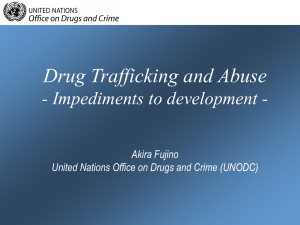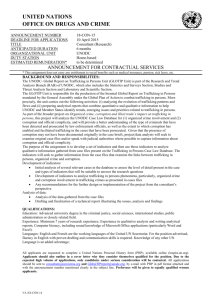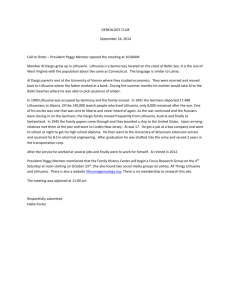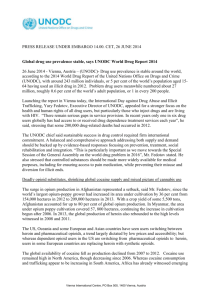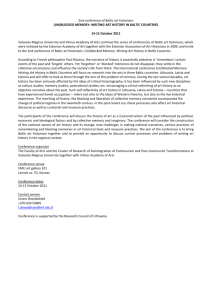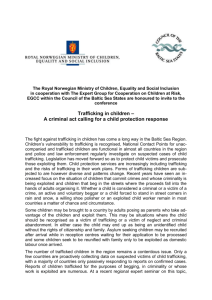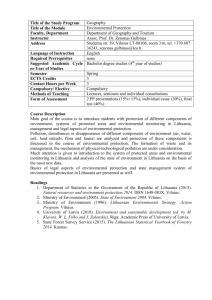Executive Director's speech at the Forum on Drug Control in the
advertisement
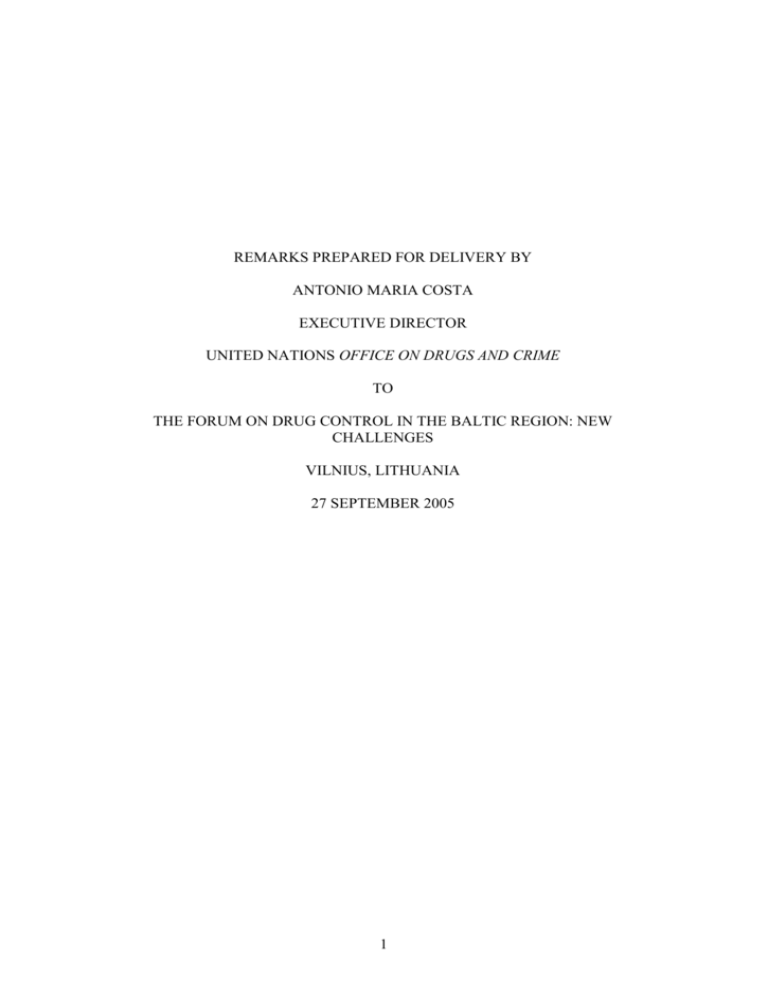
REMARKS PREPARED FOR DELIVERY BY ANTONIO MARIA COSTA EXECUTIVE DIRECTOR UNITED NATIONS OFFICE ON DRUGS AND CRIME TO THE FORUM ON DRUG CONTROL IN THE BALTIC REGION: NEW CHALLENGES VILNIUS, LITHUANIA 27 SEPTEMBER 2005 1 Excellencies, dear friends, Good Morning . . . it is a pleasure to be here. Thank you for letting me share the stage with a speaker as distinguished as Prime Minister Malgirdas Brazauskas . . . I think he’s going to be a hard act to follow. I also want to congratulate the Prime Minister, the officials gathered here today, and the government of Lithuania, for taking an open and courageous stance on drug control. It takes a great deal of courage to strike back at an enemy as powerful as this one. The globalization of trade translates into the globalization of crime, and drug trafficking, a multi-billion dollar industry, fuels a worldwide criminal underground. Let’s take a look at the global drug situation. Colombia remains the world’s leading supplier of cocaine, and Andean coke continues to inundate North America. Now, South American cocaine is also making inroads into Europe, with cartels employing routes up the coast of West Africa to move the drug into European markets, or offloading the drug in African ports and transhipping it via fishing vessels and small carriers sailing under foreign flags. So, while the United States remains the primary consumer market for cocaine, in Europe we cannot afford to be complacent – drug cartels are working aggressively to build a consumer base here, and the demand for cocaine, especially crack cocaine, is growing. Cannabis, of course, has been a problem across Western and Central Europe for years, and we see little change here—supply and demand remain relatively stable. On the other hand, synthetic drugs represent a growing problem. As you know, amphetamines are moving west to east, from the Netherlands to Belgium to Poland, and into the Baltic States. Some may be manufactured here, in Lithuania, and then exported to Russia or trafficked to Scandinavia. We know local traffickers transport Baltic amphetamines to Central Asia, where the drug is bartered for Afghan heroin that is trans-shipped back through Lithuania and on to Sweden and Norway, as well as Kaliningrad. Lithuanian authorities also understand the threat posed by the trafficking of precursor chemicals—and it is a dilemma that concerns me. Precursors are a complicated problem, given the fact that they are not in themselves illegal commodities. So we need to find creative legislative responses, and we are counting on the Baltic States, and on Lithuania, to lead the way. Now we come to the biggest challenge, Afghan heroin. In 2005, opium continues to pour across the northern border of Afghanistan, through Russia, and into the Baltic States. Enormously powerful and addictive, heroin threatens our lives, health, and security. But alarms are going off all over the world, and this forum in Vilnius is evidence people are listening. At UNODC, we’ve done an interesting study. We have ranked 187 countries according to the severity of the per capita drug problem in each nation. The first five States on the list—countries with the most severe drug problems in Europe—include Albania, at Number One . . . followed by the Netherlands, Tajikistan, Turkmenistan, Spain . . . and then Estonia, at Number 6. 2 The UK is number 7 in terms of the severity of its drug problem, followed by Kazakhstan, Belgium, Macedonia, the Russian Federation, Bulgaria, Turkey, Ireland and Italy, my own country, which lags only slightly behind at number 15. Latvia ranks 16th, and Lithuania comes in 18th. Being further down the list, in 18th place, is certainly better than being number 1, the country with the most severe drug problem per capita, but being 18th on a roster of 187 countries still means that Lithuania, as well as Estonia and Latvia, are clustered in the lowest 10th percentile of this group. That means we still have work to do. UNODC wants to help the Baltic States move further up that list of 187 countries as quickly as possible. If you look at a map, it’s easy to understand why so many countries with severe drug problems remain at risk. Their proximity to Afghanistan’s northern border, their intersection with major trafficking routes, terrain that favours smugglers, and borders that are difficult, for a number of reasons, to secure – all of this invites the efforts of traffickers and drug syndicates to protect transhipment routes across the Baltic States, to maintain the market for heroin in this region, and to broaden the already growing consumer base. In just a few weeks, UNODC will be publishing its 2005 Afghanistan Opium Survey, but we already know what’s in it, and we’ve released much of the data. The good news, which we must not overlook, is that President Karzai’s government has succeeded in reducing cultivation by 21 percent. This decline is due partly to persuasion, and partly to the fear of some farmers that the government might follow-through on its threat to eradicate illicit drug crops. The risk of losing an entire harvest is a genuine deterrent. Finally, farm gate prices also remain relatively low, and, in 2005, some growers simply decided the reward was not worth the risk. Less welcome is the news that production, the actual output of opium, did not decline significantly in 2005. In 2004, production stood at 4200 metric tons; this year, the number stands at 4100 tons. Good growing conditions, an abundance of snow and rain, triggered a high yield. We’ve also seen regional shifts in cultivation, with the greatest growth recorded in northern and southern Afghanistan. Common sense tells us that there is probably a correlation between increases in these areas and corruption. If corrupt leaders are involved in drug production or trafficking, they should be removed from office—not just moved around, as some people suggest, from one province to another, but completely removed from office. Other UNODC recommendations include: A commitment by Afghan parliament members to cut any ties to the drug industry, or resign; The extradition of major traffickers; Operations against clandestine labs; Zero-tolerance policy toward the involvement of warlords in processing and trafficking; 3 And a commitment by farmers to refrain from drug cultivation as a condition for development assistance. What we are seeing right now, after several years of drug production, is an increasing amount of opium and heroin moving across the porous northern border of Afghanistan into Central Asia, then into Russia, and from there into the Baltic States, onto the streets of Vilnius, into cities, and villages, and schoolyards across Lithuania. But the threat—as bad as it is—doesn’t stop there. The sad fact is that heroin delivers much more than just a one-time jolt. Drug users, as a population, constitute a major market for organized crime, a reliable source of illegal capital that global gangs depend on to fund a long list of other reprehensible activities: bribery, extortion, kidnapping, human trafficking, illegal arms dealing, and the smuggling of dual use technologies that could be used to develop weapons of mass destruction. There are links between drugs and terrorism, certainly between drug trafficking and the funding of regional insurgencies. The individual heroin addict also represents a source of harmful, cascading consequences for society-at-large. The addict is not only a victim himself—he or she is also a human vector for HIV/AIDS, a virus which can translate into a death sentence for injecting drug users, or anyone who comes into contact with this bloodborne plague. The virus is transmitted through sexual contact, or by any other interaction that facilitates the transmission of tainted blood cells. This means HIV/AIDS travels easily and with great speed across the borders that we once believed divided the drug using population from the general population, the homosexual population from the heterosexual, the law-breakers from the law-abiders, and even one nation from another. It is impossible, in 2005, to contain HIV/AIDS within neat, demographic boxes. But is it possible, using a more comprehensive approach, to prevent HIV/AIDS, to treat it, and to head-off what health experts say could soon be a global epidemic. We have to begin by acknowledging that drug trafficking is a business that entails extensive collateral damage. It is an industry driven by greed, fuelled by corruption, and curtailed only by international efforts that are equally focused and determined. This, of course, is where the real challenge lies—not in developing programs targeting the different, criminal consequences of trafficking and drug use, not in taking separate aim at ending supply or driving down demand—but in integrating these efforts and programs in ways that broaden their impact and increase the likelihood of a successful, comprehensive counter-attack. Transnational threats demand transnational responses—solutions that move across national borders and departmental jurisdictions as easily as the threats we seek to control. We cannot attack this problem one piece, one agency, one government at a time. In the Baltic States, you clearly agree. Indeed, you’ve provided us with concrete evidence of your willingness to reach across borders and jurisdictions . . . let me cite just a few examples: 4 The Baltic Sea Task Force on Organized Crime comprised of Heads of Governments; The Operative Committee (OPC), which brings law enforcement experts from different Baltic States together; The creation of ‘expert groups’ on human trafficking, narcotics, moneylaundering, and corruption; The melding of your drug prevention and drug control strategies within the Lithuanian Government; Your interest in working with neighbours to enhance border control; Your involvement with other nations in regard to judicial cooperation and mutual assistance – especially in the areas of money laundering, asset recovery, and extradition; Your cooperation in the fight against international terrorism; And the particular interest you have displayed in finding solutions to the problem of surges in HIV/AIDS among prison populations, and in ameliorating the consequences for the general population… These initiatives tell us that Lithuania understands the global scope and impact of organized crime, drug trafficking, and corruption, and that you are acting on this knowledge. UNODC has experience in all these areas—across the board; in curbing the explosive spread of HIV in prisons; in helping States secure the international supply chain; in facilitating mutual judicial cooperation and strengthening the rule of law, and in helping countries around the world respond to the same kind of threats currently confronting this region. Lithuania has also signed both the Convention against Transnational Organized Crime, and its Protocols against Trafficking in Women and Girls, and against the Smuggling of Migrants. In 2002, UNODC gave the UN Vienna Civil society Award to the Missing Persons Family Support Centre. This NGO, headed by Ms. Ona Gustiene, is leading the effort to raise awareness about human trafficking in Lithuania. I have just returned from a mission in Moscow, where our purpose was also to focus attention on human trafficking. The response in Russia was extraordinary; officials there were not just willing, but eager to talk about issues that had previously been taboo. I think we are going to see Russia move ahead quickly in this area, and I think Lithuania has similar opportunities. Again, at UNODC, we are ready to provide any technical assistance or advocacy efforts you think might be helpful. Lithuania is a signatory to the UN Convention against Corruption as well, and we hope you will ratify the treaty quickly. As you may know, the CAC received its 30 th ratification only two weeks ago during the Summit in New York, and will enter into force around December 13th. We will be participating in the International Day against Corruption around the same time, and I would like to invite your governments to support that event as well. I hope this abbreviated overview of so many large problems has been helpful. I think we are on the same track – the right one, and that our job now is to create the kind of smart partnerships governments, NGOs, and UNODC need to move seamlessly and effectively toward the realization of common, and very critical goals. Having said 5 that, let me finish these remarks the same way I began, by congratulating the Government of Lithuania, the many dedicated officials who are here today, and the participants in this Forum for taking so many important “first steps” together on what promises to be a long journey. Thank you. 6
